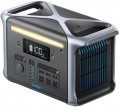Add to comparison |  |  |
|---|---|---|
| ANKER SOLIX F1500 | ANKER SOLIX F1200 | |
| Compare prices 1 | Compare prices 3 | |
| User reviews | ||
| TOP sellers | ||
4 USB A ports, 2 USB C ports. Car cigarette lighter. LiFePo4 battery. Backlight. UPS function. | 4 USB A ports, 2 USB C ports. Car cigarette lighter. LiFePo4 battery. Backlight. UPS function. | |
| In box | charging station | charging station |
| Rated power | 1800 W | 1500 W |
| Peak power | 2400 W | 3000 W |
| Output waveform | sinusoid (PSW) | sinusoid (PSW) |
| UPS function | ||
Outputs | ||
| Sockets (230 V) | 2 | 2 |
| USB A | 4 5В/2.4А 12 W | 4 5В/2.4А 12 W |
| USB C | 2 3 A, 5 A 100 W | 2 3 A, 5 A 100 W |
| Car cigarette lighter | ||
Inputs (station charging) | ||
| From solar panels | ||
| Input port XT60 | ||
| Add. ports | C13/14 (charging) | C13/14 (charging) |
Battery and charging time | ||
| Battery type | LiFePO4 | LiFePO4 |
| Battery capacity | 1536 W*h | 1229 W*h |
| Charging cycles | 3000 | 3000 |
| Charging time (socket) ≈ | 120 min | 90 min |
| Charging time (solar panel) ≈ | 216 min | 246 min |
| Charging time (cigarette lighter) ≈ | 912 min | 828 min |
| Charging power (socket) | 1000 W | 1000 W |
| Charging power (solar panel) | 600 W | 300 W |
| Charging power (cigarette lighter) | 120 W | 120 W |
General | ||
| PSU | built into the body | built into the body |
| Display | ||
| Backlight | ||
| Carrying handle | ||
| Operating temperature | 0 °C ~ +40 °C | 0 °C ~ +40 °C |
| Dimensions | 288x463x237 mm | 288x463x237 mm |
| Weight | 19.8 kg | 19.9 kg |
| Warranty | 5 years | |
| Added to E-Catalog | july 2024 | december 2022 |
The ANKER SOLIX F1500 and ANKER SOLIX F1200 charging stations have similar features but differ in power and battery capacity. The F1500 offers a rated power of 1800W and peak power of 2400W, while the F1200 has a rated power of 1500W and peak power of 3000W. The battery capacity of the F1500 is 1536 Wh, which is greater than the 1229 Wh of the F1200. Both devices support UPS functionality and have the same number of outputs, including 4 USB A ports and 2 USB C ports. Users note the high reliability and ease of use of both models; however, the F1500 may be preferred for those who require more power and capacity.